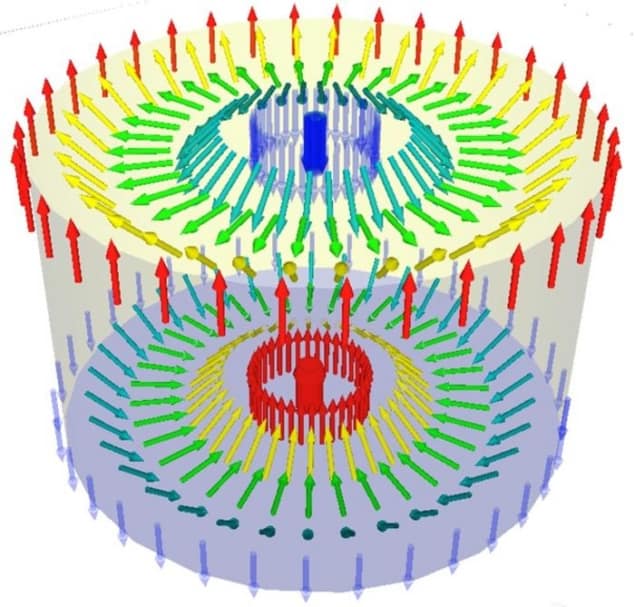
Skyrmions – quasiparticles with a vortex-like structure – can be made to diffuse more than 10 times faster than their natural drift rate in specially-designed materials developed by researchers in Germany and Japan. This speedier movement could come in handy for novel forms of computing that work using random (stochastic) processes like the Brownian motion of particles.
Skyrmions are made up of numerous electron spins and can be thought of as two-dimensional whirls (or “spin textures”) within a material. They exist in many magnetic materials, including cobalt–iron–silicon and the manganese–silicide thin films in which they were first discovered. As well as being of interest in fundamental condensed-matter physics, skyrmions have attracted considerable attention in recent years as a possible basis for future hard-disk technologies.
Today’s hard disks store information in magnetic domains, which are areas where all magnetic spins are aligned in the same direction. There are fundamental restrictions on how small these domains can be, which limits storage capacities. Skyrmions, in contrast, measure just tens of nanometres across, and could therefore be used to create storage devices with much higher densities. A further advantage is that whereas flipping all the spins in conventional domains – to switch a device’s memory state from 1 to 0, for example – requires a considerable amount of power and can be slow, a skyrmion-based switch would require many fewer spin flips. In addition, the final spin state in such a system would be robust against external perturbations, making skyrmion structures more stable than conventional magnetic domains.
Stochastic dynamics for highly energy-efficient computers
Skyrmions can be made to move by applying a small external electric current to a magnetic thin film, but they also move naturally, and randomly, thanks to diffusion. Such stochastic dynamics have attracted much interest recently because they could be exploited to make highly energy-efficient computers, says Takaaki Dohi, a spintronics researcher at the University of Tohuku who led the development of the new materials.
Dohi notes that the distinct topological properties of magnetic skyrmions give rise to a special version of the Magnus force, which lifts spinning objects as they move through a fluid. The gyrotropic force, as it is known, makes ferromagnetic skyrmions move in circles rather than along straight lines. This circular motion drastically reduces the skrymions’ diffusive motion compared to that of normal Brownian particles, which (as laid out by Albert Einstein in his landmark 1905 study of Brownian motion) exhibit an inverse relationship between particle friction and the diffusion coefficient.
Importantly, though, the direction of the skyrmions’ circular motion (clockwise or anticlockwise) depends on a property known as their topological charge, which relates to the winding number of their whirl-like structures. This means that if two skyrmions with opposite winding numbers can be coupled together, their respective gyrotropic forces will cancel out and their diffusive motion will increase. A computer based on this type of “gyrotropic-compensated” skyrmions would thus be faster and would consume less energy .
Increased skyrmion diffusion
Dohi and colleagues at the Johannes Gutenberg University in Mainz and the University of Konstanz have now demonstrated this type of coupling-based compensation in multilayer stacks of materials. Each stack is composed of two individual ferromagnetic layers made from cobalt-iron-boron that are separated by an iridium spacer. By controlling the thickness of this structure, the researchers could tailor the sign and strength of the antiferromagnetic exchange coupling between the layers. By varying the thickness of the individual ferromagnetic layers, they could control the net spin. “In this way we can tune the two competing gyrotropic forces to compensation,” Dohi says. “For 90% compensation, for example, we find that the diffusion coefficient enhances by more than a factor of 10 compared to a ferromagnetic skyrmion.”
In their study, which they describe in Nature Communications, the researchers investigated the movements of skyrmions using the magneto-optical Kerr effect (MOKE), which detects the net magnetization of both ferromagnetic layers. They were therefore not able to explore the limit of 100% compensation, for which their theory predicts an even larger increase in diffusion. “This is why we are looking into other (electrical or optical) means that might allow us to go to this limit,” Dohi says. “For instance, a magnetic tunnel junction placed at the top of a synthetic ferromagnetic could resolve this problem.”

Motion of a single skyrmion is controlled at room temperature
While skyrmions in naturally occurring antiferromagnets should also diffuse faster than their ferromagnetic counterparts, experiments to date have found that they suffer from strong “pinning”, which slows down their movement. “Our result shows that synthetic antiferromagnets are better in this this regard since they combine the low pinning advantages of ferromagnets and the fast dynamics of antiferromagnets,” Dohi tells Physics World.
The researchers are also exploring ways to decrease the size of the skyrmions in the synthetic antiferromagnets as well as further reducing their pinning. “Both these aspects are crucial for the scalability and energy efficiency of possible future devices that exploit these quasiparticles,” he concludes.
- SEO Powered Content & PR Distribution. Get Amplified Today.
- PlatoData.Network Vertical Generative Ai. Empower Yourself. Access Here.
- PlatoAiStream. Web3 Intelligence. Knowledge Amplified. Access Here.
- PlatoESG. Carbon, CleanTech, Energy, Environment, Solar, Waste Management. Access Here.
- PlatoHealth. Biotech and Clinical Trials Intelligence. Access Here.
- Source: https://physicsworld.com/a/tailored-material-makes-speedier-skyrmions/



